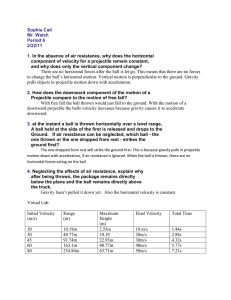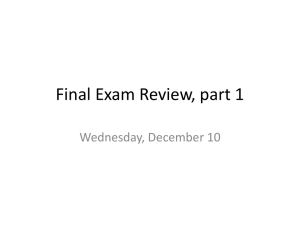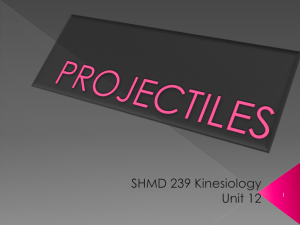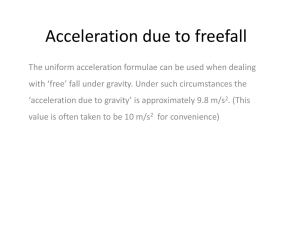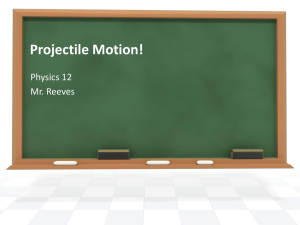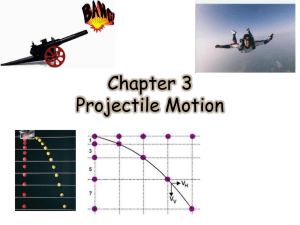Free Fall & Projectile Motion: Physics Presentation
advertisement
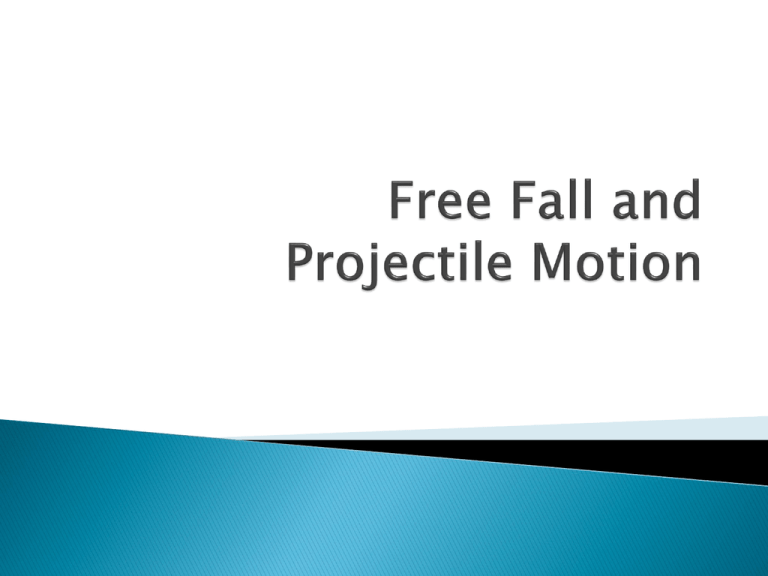
Galileo Galilei was the first to make an analysis of the motion of freely falling objects. Based on his experimentations and reasoned deductions, Galileo concluded that all objects on earth, in the absence of air resistance would fall with the same constant acceleration due to gravity. _______ t = /2d/g a = (vf – vi)/t d = [(vi + vf)t]/2 where g is the acceleration due to gravity (980cm/sec2 or 9.8 m/sec2) A stone is dropped into the river from a bridge 7.0 high. How long would it take before the stone crashes into the water? Given: d = 7.0m g = 9 .8 m/s2 Required: t Solution: _______ t = /2d/g ___________________________ /2(7.0 m)/9.8 m/s2 t = t = 1.2 s a. What is the bullet’s speed at the peak of its path? Given: vi = 300 m/s a = -9.8m/s2 The speed of the bullet at the peak of its path is zero since that is the point the object is at rest and has lost all speed it initially has due to deceleration. b. What is its deceleration on its way up? At the peak? Its acceleration on its way down? The deceleration of the object on its way up is 9.8m/s2. At the peak it is 9.8 m/s2 downward. And on its way down the object increases its speed and therefore accelerates with a rate of 9.8 m/s2. It is important to note the acceleration due to gravity is taking effect at any point during the object’s flight. c. How high is this peak? To solve for the height of the peak we concentrate on the upward motion until the object reaches the peak. During this segment the initial speed vi = 300 m/s. The final speed vf = 0 since the object is at rest at the peak. The acceleration is -9.8 m/s2. We use the equation d = [(vi + vf)t]2 to solve for the height where t can be solved using a = (vf – vi)/t. t = (vf – vi)/a = (300m/s - 0)/-9.8m/s2 = 31 sec d = [(vi + vf)t]/2 = [(300m/s + 0)31s]/2 = 4650 meters d. Find the time the bullet will take to reach its starting point from the moment it is shot? The total time of flight which is the time to go up plus the time to go down is twice 31s (the value going up) equal to 62 seconds. 1. A ball is dropped from the window of a three-storey apartment. How far has it fallen after one second? What is the ball’s velocity after one second of fall? How far does the ball fall during the next second? Assume no air resistance. 2. Carlo threw a ball upward with an initial velocity of 2000 cm/s and was able to catch it before it reached the ground on its return. a. What was its velocity after 1s? b. What was its displacement in the first second? c. How long did it take the ball to reach its maximum height? d. How far was the maximum height from the starting point? e. What was its final velocity just before it touched Carlo’s hand? f. How long will it take the ball to reach a point 1000 cm above Carlo’s hand on its way down? 3. A car was moving at 70 m/h when the driver saw a boy crossing the road. The driver was able to stop the car in 3.8sec and just avoided hitting the boy. Determine: a. thinking distance if the driver’s reaction time is 0.75 sec. b. uniform deceleration when brakes were applied, and c. stopping distance of the car A ball is thrown straight up so that it reaches a maximum height of 30m. 1. How long did it take the ball to go up? 2. How fast was it going when it was 20m high from the ground? Projectile – an object or body thrown in a curved path given an initial velocity and whose motion is influenced by the pull of gravity Trajectory – the path of a projectile that is principally determined by two types of motion (horizontal and vertical motion) Projectile motion – motion of a body thrown in a curved path with constant acceleration Free Fall Projectile Vertical Motion Vertical and Horizontal Motion Motion contains horizontal &vertical components Distance is total horizontal distance (range) d = dx Motion is accelerated due to gravity Distance is height D=h t = √(2d)/g t = dx/v Suppose that a coin rolls off the edge of a table 1.5 m high at a horizontal speed of 1.0 m/s. a. Find the time it would take before it lands on the floor b. How far from the base of the table will it land? 2. A little girl throws her jackstone ball horizontally out of the window with a velocity of 30m/sec. If the window s 3.0 meters above the ground level, how far will the ball travel before it hits the ground? 1. R = [vo2 sin θ]/g = vo2 [2sin θ cos θ] /g T = [2vo sin θ]/g H = [vo2 sin2θ]/2g 1. An arrow leaves a bow at 30 m/sec at an angle 30o from the horizontal. a. What is its maximum range? b. Find the maximum height of the arrow. c. How long would the arrow take to land on the other side exactly opposite where it is launched? 2. A projectile is thrown with a speed of 100 m/sec in a direction 30o above the horizontal. Find the height to which it rises, the time of flight, and the horizontal range.
